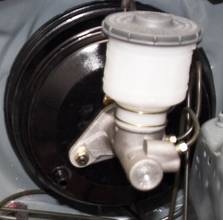
A properly functioning brake system is one of the most important safety features on your car. Regular maintenance of this system requires periodic inspection and servicing of the components involved. Servicing brakes is not physically difficult, but does require attention to detail and knowledge of the components involved.
Inspect the brake fluid level in the brake reservoir located under the hood next to the master cylinder and firewall. This reservoir will have a minimum and maximum line molded into the plastic housing. Make sure that the fluid level falls between these two marks. If it is low, remove the cap and fill to the maximum line, being careful not to get any dirt in the reservoir.
Inspect the brake lines that run from the brake master cylinder to each of the four tires. If any leaks are present, the line should be replaced. Any cracking or flaking from the flexible rubber lines are indicators that those lines should also be replaced.
Remove the four tires (one at a time, unless you have access to a garage with a lift) and examine the brake pads. If the pads are glazed from overheating, unevenly worn or cracked, or if they are worn to the point that the metal brads are showing through, then it is time to replace the brake pads.
Examine each rotor or drum while the tires are removed to check for uneven wear from breaking. If there are deep grooves, or if the surface has an uneven or warped feel to it, then the drum or rotor needs to be turned at a professional brake shop. Turning a rotor is the process where the uneven grooves are removed by a special metal lathe. Professionals must also measure the rotor or drum to ensure that there is enough metal left to resurface the item and maintain minimum safety thicknesses.
Take a test drive to feel for any inconsistencies in the brakes. Soft or squishy brakes indicate that there is air in the brake lines and the brakes need to be bled. If the steering wheel pulls to one side when braking to a stop, this indicates that the front brakes need to be adjusted and/or possibly replaced. Vibrations or pulsating brakes indicate that the there is uneven wear on the brakes or the rotors and drums. Additionally, the emergency brake should be tested to ensure that it prevents the vehicle from going forward or backwards when it is applied.